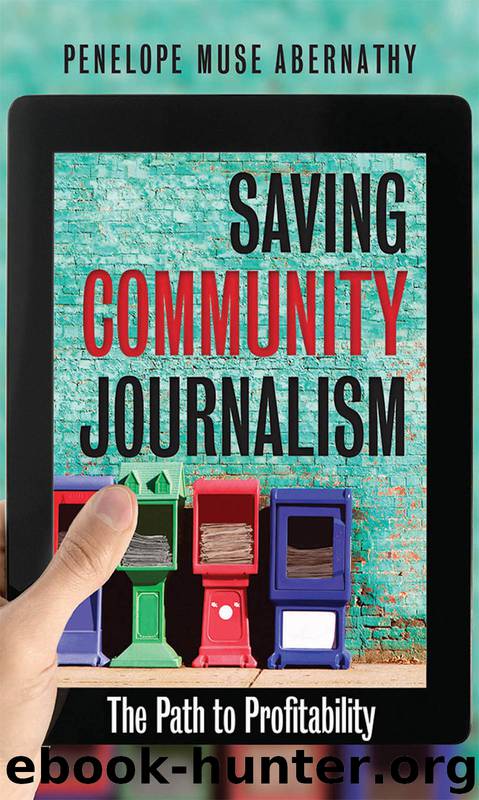Saving Community Journalism by Penelope Muse Abernathy

Author:Penelope Muse Abernathy
Language: eng
Format: epub
Publisher: The University of North Carolina Press
Published: 2014-04-15T00:00:00+00:00
Building Special-Interest Communities
The interconnectivity of the Internet gives us the ability to escape physical boundaries and form virtual communities of friends and neighbors who share our concerns, our passions, or our affiliations with certain groups or organizations—such as sports, parenting, civic life, politics, or religion. We can connect directly with these “communities of special interests,” bypassing the more “general interest” news that is typically on the home page of most newspaper websites.
Among readers, the Internet has created a “shift in priorities from the [geographically defined] community to the individual,” says Northwestern’s Mersey, who believes that newspapers have “effectively ignored individual-based needs.” Recent research on consumer behavior has found “that people who find a product more useful are more likely to use it, and targeted products tend to be more useful,” she says. “In fact, special media, including narrowly cast magazines, have performed relatively well by comparison to general-circulation media.”
As Mersey points out, magazines, which pioneered the concept of catering to the special affiliations and affinities of their readers, have been rewarded with a loyalty that has endured over the last several decades. Despite the rise of the Internet, annual surveys reveal strong reader attachment to “special-interest” magazines today, regardless of age. Eighty percent of respondents in a recent Deloitte survey, which has tracked generational shifts in media consumption for the last decade, reported making time on a routine basis to read a “favorite” magazine. This included twenty-one-year-olds in the “millennial generation” and baby boomers who are pushing sixty-five. By fostering this engagement of devoted readers, many magazines have been able to gain pricing leverage with their advertisers, providing them with very efficient access to a highly targeted audience. Over the last decade, as the mass audience for television has fragmented, cable networks have also followed a similar strategy—branding themselves to appeal to certain target audiences—and enjoyed success with both viewers and advertisers.
Therefore, as they consider how to pursue new revenue opportunities in a digital world, newspapers need to view the creation of these communities built around either “affinities, affiliations, or affections” as an opportunity to enhance loyalty with both readers and advertisers. This means that, in addition to building vibrant geographic community online, newspaper editors must also consider how to build and nurture “communities of special interest”—most especially if they hope to attract a new generation of readers that are addicted to the interconnectivity and interactivity of the digital era.
The challenge for editors trying to build community based on geographic identity is that of getting readers to “care about” the journalism. In contrast, when building communities based on special interests, the journalistic challenge is figuring out how best to connect readers with the content, each other, and the newspaper, as well as with the advertisers who want to reach them. Readers already “care about” these topics; the paper needs to provide the appropriate forum for them to connect in as many ways as possible.
Creating “communities of special interest” involves a whole new way of thinking about how to create and
Download
This site does not store any files on its server. We only index and link to content provided by other sites. Please contact the content providers to delete copyright contents if any and email us, we'll remove relevant links or contents immediately.
Bad Blood by John Carreyrou(6584)
Rich Dad Poor Dad by Robert T. Kiyosaki(6517)
Principles: Life and Work by Ray Dalio(6298)
Playing to Win_ How Strategy Really Works by A.G. Lafley & Roger L. Martin(6090)
Management Strategies for the Cloud Revolution: How Cloud Computing Is Transforming Business and Why You Can't Afford to Be Left Behind by Charles Babcock(4548)
The Confidence Code by Katty Kay(4222)
Thinking in Bets by Annie Duke(4186)
American Kingpin by Nick Bilton(3822)
Delivering Happiness by Tony Hsieh(3397)
Project Animal Farm: An Accidental Journey into the Secret World of Farming and the Truth About Our Food by Sonia Faruqi(3191)
The Power of Habit by Charles Duhigg(3097)
The Tyranny of Metrics by Jerry Z. Muller(3032)
Brotopia by Emily Chang(3029)
Mastering Bitcoin: Programming the Open Blockchain by Andreas M. Antonopoulos(3015)
The Marketing Plan Handbook: Develop Big-Picture Marketing Plans for Pennies on the Dollar by Robert W. Bly(3007)
I Live in the Future & Here's How It Works by Nick Bilton(2963)
The Content Trap by Bharat Anand(2889)
Applied Empathy by Michael Ventura(2865)
Building a StoryBrand by Donald Miller(2865)
